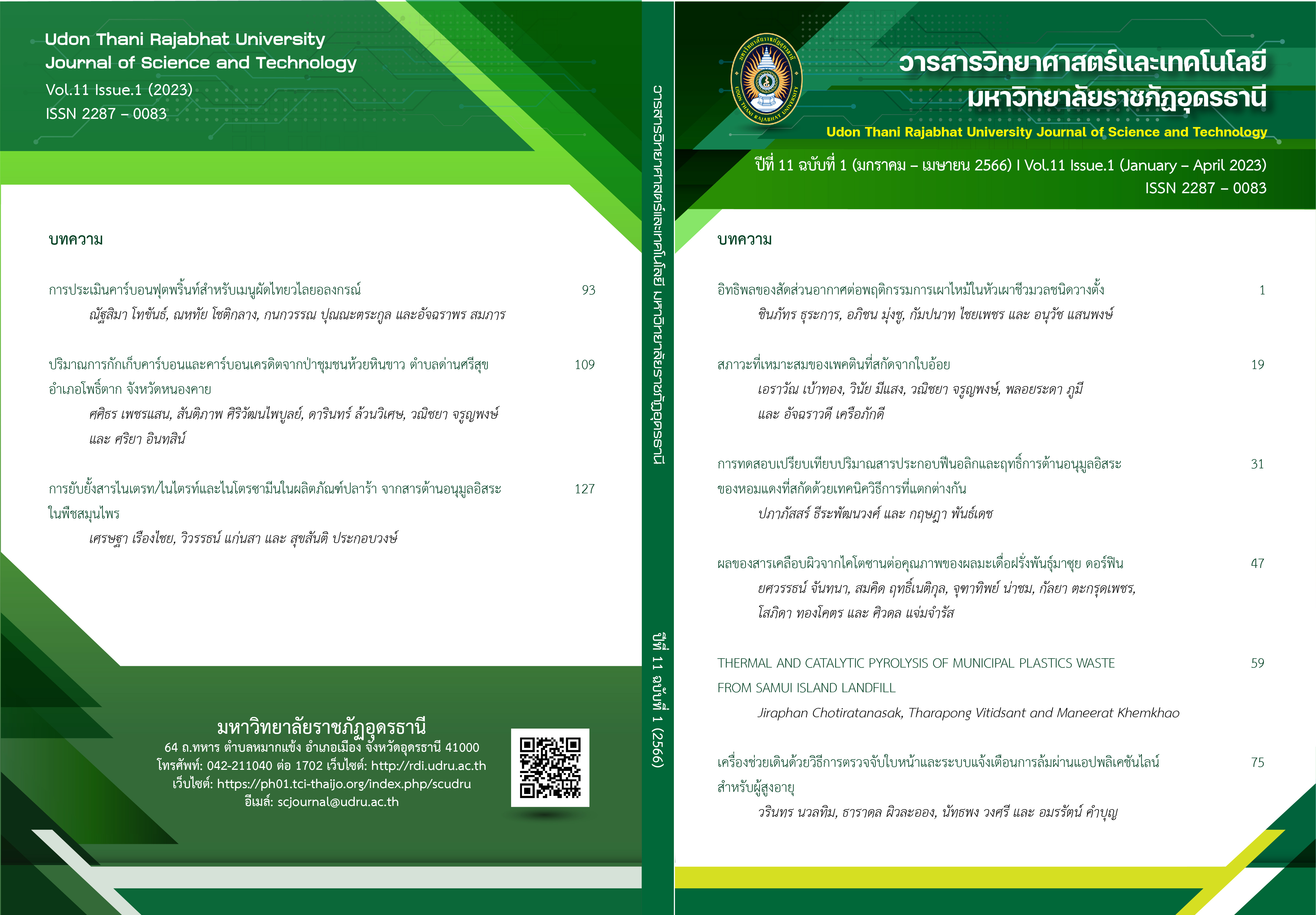การทดสอบเปรียบเทียบปริมาณสารประกอบฟีนอลิกและฤทธิ์การต้านอนุมูลอิสระของหอมแดงที่สกัดด้วยเทคนิควิธีการที่แตกต่างกัน
Main Article Content
บทคัดย่อ
กลุ่มโรคไม่ติดต่อเรื้อรัง (NCDs) เป็นปัญหาด้านสุขภาพที่สำคัญในปัจจุบัน สาเหตุหลักเกิดจากพฤติกรรมเสี่ยงในการดำเนินชีวิต เช่น การรับประทานอาหารที่ไม่ถูกสุขลักษณะ ขาดการออกกำลังกาย มีความเครียดสูงจากสภาพสังคมและสิ่งแวดล้อม ปัจจัยเหล่านี้ทำให้เซลล์ในร่างกายมีการสร้างสารอนุมูลอิสระมากขึ้น ซึ่งสารเหล่านี้จะไปกระตุ้นกระบวนการออกซิเดชั่นส่งผลกระทบต่อการทำงานของเซลล์ในร่างกายและนำไปสู่การเกิดโรคต่างๆ ได้ งานวิจัยก่อนหน้านี้ พบว่า สารสกัดจากผักและผลไม้มีความสามารถในการเป็นสารต้านอนุมูลอิสระได้ หอมแดง (Allium ascalonicum L.) เป็นพืชที่ปลูกมากในเขตภาคอีสานและเป็นหนึ่งในพืชที่มีการรายงานถึงคุณสมบัติในการต้านอนุมูลอิสระที่สัมพันธ์กับการเกิดโรคไม่ติดต่อเรื้อรังดังกล่าว โดยมีวิธีการในการสกัดสารสำคัญที่หลากหลายและแตกต่างกันออกไป ดังนั้น งานวิจัยในครั้งนี้จึงมีวัตถุประสงค์เพื่อศึกษาเปรียบเทียบปริมาณสารประกอบ ฟีนอลิกและฤทธิ์การต้านอนุมูลอิสระของหอมแดงที่สกัดด้วยเทคนิควิธีการที่แตกต่างกัน 3 วิธี ได้แก่ 1) สกัดด้วยน้ำกลั่น (DW) 2) สกัดด้วยน้ำกลั่นที่อุณหภูมิ 60 องศาเซลเซียส นาน 10 นาที (DW+B60 ํC) และ 3) สกัดด้วยเอทิลแอลกอฮอล์ 50 เปอร์เซ็นต์ (A50) จากนั้นนำไปทดสอบหาปริมาณสารประกอบฟีนอลิกด้วยวิธี Folin-Ciocalteu และปริมาณฟลาโวนอยด์ด้วยวิธี Flavonoid Assay ฤทธิ์การต้านอนุมูลอิสระด้วยวิธี DPPH, FRAP และ Nitric oxide (NO) radical scavenging assay ผลการวิจัยพบว่า หอมแดงที่สกัดด้วยน้ำกลั่นที่อุณหภูมิ 60 องศาเซลเซียส นาน 10 นาที (DW+B60 ํC) มีปริมาณสารประกอบฟีนอลิกและฟลาโวนอยด์สูงกว่าหอมแดงที่สกัดด้วยน้ำกลั่น (DW) และสกัดด้วยเอทิลแอลกอฮอล์ 50 เปอร์เซ็นต์ (A50) มีค่าเท่ากับ 9.07±0.32 mg/L GAE/mg extract และ 1.226±0.017 mg/L quercetin/mg extract และมีฤทธิ์ต้านอนุมูลอิสระ โดยการทดสอบด้วยวิธี DPPH และ FRAP ที่ดีที่สุด โดยมีความสามารถในการต้านอนุมูลอิสระที่ 50 เปอร์เซ็นต์ (IC50) มีค่าเท่ากับ 8.65±0.01 และ 20.86±0.43 mg/mL ตามลำดับ อีกทั้งยังพบว่ามีความสามารถในการยับยั้ง NO สูงที่สุด มีค่าเปอร์เซ็นต์เท่ากับ 27.22±0.30 การวิจัยในครั้งนี้ แสดงให้เห็นว่าหอมแดงที่สกัดด้วยน้ำกลั่นที่อุณหภูมิ 60 องศาเซลเซียส นาน 10 นาที (DW+B60 ํC) เป็นวิธีการสกัดสารที่มีประสิทธิภาพดีกว่าการสกัดด้วยน้ำกลั่น (DW) และสกัดด้วยเอทิลแอลกอฮอล์ 50 เปอร์เซ็นต์ (A50) ที่อุณหภูมิห้อง โดยผลของความร้อนที่เหมาะสมอาจเป็นปัจจัยหนึ่งที่สำคัญที่สามารถช่วยให้การสกัดสารสำคัญในหอมแดงมีประสิทธิภาพสูงขึ้น
Article Details
เอกสารอ้างอิง
Aktas, N., Genc, Y., Gozcelioglu, B., Konuklugil, B., & Harput, U. S. (2013). Radical scavenging effect of different marine sponges from Mediterranean coasts. Records of Natural Product, 7(2), 96-104.
Alexander Victor, A. D., Radhakrishnan, A., & Subramani, P. (2016). Overviews of Biological Importance of Quercetin: A Bioactive Flavonoid. Pharmacognosy Reviews, 10(20), 84–89.
Benzie, I. F., & Strain, J. J. (1996). The ferric reducing ability of plasma (FRAP) as a measure of "antioxidant power": the FRAP assay. Analytical Biochemistry, 239, 70-76.
García-Trejo, E. M., Arellano-Buendía, A. S., Argüello-García, R., Loredo-Mendoza, M. L., García-Arroyo, F. E., Arellano-Mendoza, M. G., Castillo-Hernández, M. C., Guevara-Balcázar, G., Tapia, E., Sánchez-Lozada, L. G., & Osorio-Alonso, H. (2016). Effects of Allicin on Hypertension and Cardiac Function in Chronic Kidney Disease. Oxidative Medicine and Cellular Longevity, 2016, 1-13. doi: 10.1155/2016/3850402.
Che Sulaiman, I. S., Basri, M., Fard Masoumi, H. R., Jian Chee, W., Efliza Ashari S., & Ismail, M. (2017). Effects of temperature, time, and solvent ratio on the extraction of phenolic compounds and the anti-radical activity of Clinacanthus nutans Lindau leaves by response surface methodology. Chemistry Central Journal, 11, 1-11. doi: 10.1186/s13065-017-0285-1.
Jiri, M., Tunde, J., Sona, S., & Jiri, S. (2016). Quercetin and Its Anti-Allergic Immune Response. Molecules, 21(5), 623-637.
Ji-Sook, L., Yong-Jun, C., Kyung-Hea, L., & Jung-Eun, Y. (2016). Onion peel extract reduces the percentage of body fat in overweight and obese subjects: a 12-week, randomized, double-blind, placebo-controlled study. Nutrition Research and Practice, 10(2), 175-181.
Jun, Y., Katherine, J. M., Jan van, D. H., & Rui, H. L. (2004). Varietal differences in phenolic content and antioxidant and antiproliferative activities of onions. Journal of Agricultural and Food Chemistry, 52(22), 6787-6793.
Maja, D., Verica, D. U., Marija, P., Mladen, B., Tomislav, B., & Branka, L. (2013). The effect of extraction solvents, temperature and time on the composition and mass fraction of polyphenols in dalmatian wild sage (Salvia officinalis L.) extracts. Food Technology and Biotechnology, 51(1), 84-91.
Mariangela, M., Valentina, A., Giancarlo, S., & Filomena, C. (2019). Biological Properties and Bioactive Components of Allium cepa L.: Focus on Potential Benefits in the Treatment of Obesity and Related Comorbidities. Molecules, 19-36.
Quettier-Deleu, C., Gressier, B., Vasseur, J., Dine, T., Brunet, C., Luyckx, M., Cazin, M., Cazin, J. C., Bailleul, F., Trotin, F. (2000). Phenolic compounds and antioxidant activities of buckwheat (Fagopyrum esculentum Moench) hulls and flour. Journal of Ethnopharmacology, 72, 35-42.
Razieh, J., Sayyed, M. B., Ali, M., & Morteza, B. R. (2007). Hypoglycemic Effect of Aqueous Shallot and Garlic Extracts in Rats with Fructose-Induced Insulin Resistance. Journal of Clinical Biochemistry and Nutrition, 41(3), 218-223.
Sanaz, M., Behnod, A., Leila, D., Mehdi, A., Esfahani, Zahra, M., Hossein, K. B., & Reza, G. (2017). Effects of yogurt and yogurt plus shallot consumption on lipid profiles in type 2 diabetic women. International Journal of Preventive Medicine, 8(54), 1-4.
Tai, A., Sawano, T., Yazama, F., & Ito, H. (2011). Evaluation of antioxidant activity of vanillin by using multiple antioxidant assays. Biochimica et Biophysica Acta, 1810, 170-177.
Warangkana, A., Soraya, K., Sunee, C., Nutthiya, H., Saisawat, C., Masaaki, T., & Hirotoshi, T. (2019) Antiallergic activities of shallot (Allium ascalonicum L.) and its therapeutic effects in allergic rhinitis. Asian Pacific Journal of Allergy and Immunology, 40(4), 393-400.
Yin, L., Zhuojin, H., Xiuying, S., Xiaolu, X., Jie, F., Shaohua, W., & Deyong, Z. (2012). Cholesterol-Lowering Effect of Allicin on Hypercholesterolemic ICR Mice. Oxidative Medicine and Cellular Longevity, 1-6.


